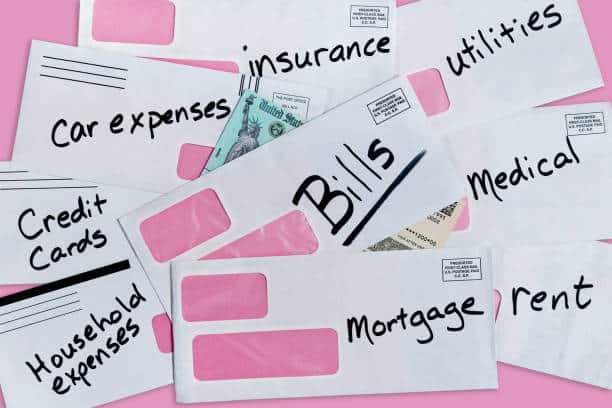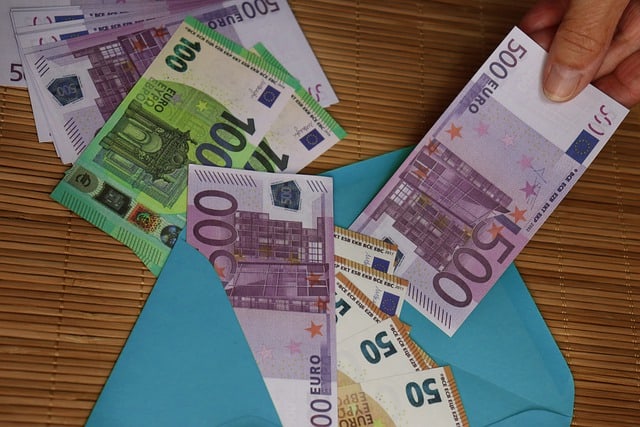Envelope Budgeting Categories: Become a smart spender today!
Let me introduce you to Cash Envelope Budgeting – a not-so-secret weapon for achieving financial freedom without breaking a sweat.
Have you ever felt like your money slips through your fingers faster than you can account for? How would you feel if you knew exactly what you are spending on each month?
“According to a recent survey, 87% of individuals who use envelope budgeting categories report having better control over their spending.”
— Money Magazine
Financial freedom and stability are achievable goals when you have a clear and effective budgeting strategy in place. One such strategy that has gained popularity in recent years is cash envelope budgeting.
This method empowers you to take control of your finances by categorizing your expenses and allocating funds accordingly.
Understanding Envelope Budgeting

Imagine you have envelopes for every spending category in your life – rent, groceries, movie nights, and even that guilty pleasure, online shopping. You divvy up your cash into these envelopes, and once an envelope is empty, that’s it! No more spending on that category until it’s time to refill. Simple, right?
This approach helps you visualize and limit your spending in different areas of your life.
Benefits of Envelope Budgeting

Envelope budgeting is more than just a money management technique; it’s a powerful tool that can transform the way you handle your finances.
Let’s dive deeper into the benefits of envelope budgeting:
Control Over Spending

Have you ever experienced the frustration of looking at your bank account at the end of the month and wondering where all your money went? It’s a common problem, but envelope budgeting offers a straightforward solution.
Envelopes are like guardians of your financial boundaries. By assigning a specific amount of cash to each spending category, you create a clear limit. When that envelope is empty, it’s a signal to stop spending in that category until the next budgeting period. This mechanism empowers you to regain control over your spending habits.
Imagine you have a dining-out envelope with $100 inside. As you dine out during the month, you subtract the cost from that envelope. When it’s empty, you have a choice: either dine in or reallocate funds from another category if possible.
This practical approach makes you conscious of every dollar you spend, preventing impulsive or mindless spending.
Envelope budgeting puts you firmly in charge, ensuring that you don’t overspend or make financial decisions without considering the consequences. It’s a proactive way to manage your money rather than reacting to the aftermath of overspending.
Savings and Debt Reduction

Building savings and tackling debt are key steps on the road to financial stability and freedom. Envelope budgeting is a reliable ally in achieving these financial goals.
Let’s start with savings. When you create a budgeting category for savings or specific financial goals (like an emergency fund, vacation, or a down payment on a house), you’re allocating a portion of your income directly to these objectives. This systematic approach ensures that you consistently set aside money for your future.
Money allocated to the savings envelope is off-limits for other spending purposes, making it less likely that you’ll dip into your savings for impulsive purchases. This discipline is crucial for accumulating funds for emergencies or long-term aspirations.
Now, let’s talk about debt reduction. Envelope budgeting allows you to designate a category specifically for debt repayment. Whether it’s credit card debt, student loans, or any other outstanding balances, this category ensures that a portion of your income is dedicated to paying down debt.
By systematically chipping away at your debts using envelope budgeting, you not only reduce the overall interest you’ll pay but also improve your credit score. As your debt decreases, you’ll free up more funds for other financial priorities, putting you on a faster track to financial freedom.
Financial Awareness

In today’s fast-paced world, it’s easy to lose track of your financial transactions and lose sight of your financial goals. This is where envelope budgeting excels as a financial mindfulness exercise.
With envelope budgeting, you’re forced to confront the reality of your spending habits. You’ll become acutely aware of where every dollar goes, which is the first step toward meaningful financial improvement.
This awareness can be eye-opening and transformative.
Consider the act of physically taking money from an envelope to make a purchase. It’s a tangible reminder of the trade-off between your immediate desires and your long-term financial goals. This awareness encourages you to make intentional choices about how you allocate your resources.
Moreover, by regularly reviewing the contents of your envelopes and tracking your spending, you gain insight into your financial patterns. You’ll identify areas where you consistently overspend and areas where you might have room to save more. This self-discovery is invaluable, as it empowers you to make informed decisions about your financial future.
Importance of Envelope Budgeting Categories

Why Budgeting Categories Matter
Picture this: You have a pile of cash, and you need to make it stretch until the end of the month. Without budgeting categories, you’re like a kid in a candy store – tempted to splurge on everything. But categories keep you focused on what really matters.
Budgeting categories are the foundation of envelope budgeting. They help you prioritize spending and ensure you allocate enough funds to essential expenses while allowing for discretionary spending.
Creating Your Envelope Budgeting Categories

Creating your envelope budgeting categories is a critical step in the process, as it forms the foundation for effective money management. Here’s an in-depth exploration of each step involved in establishing these categories:
Analyzing Your Income
Understanding your income is the starting point of creating your envelope budget. Your income serves as the pool from which you’ll allocate funds to various spending categories. Begin by assessing the nature of your income:
Fixed Salary: If you have a regular job with a consistent monthly income, this is relatively straightforward. You have a clear picture of how much money you can rely on each month.
Irregular Income: Some individuals, such as freelancers or commission-based workers, have income that fluctuates from month to month. In this case, it’s essential to estimate a reasonable average monthly income based on past earnings. This will help you create a stable budget even with income variability.
Combination of Sources: If your income comes from multiple sources, such as a part-time job, rental income, or investments, make sure to account for each source separately. This allows you to track income streams individually and allocate funds accordingly.
Understanding your income provides clarity about your financial resources and sets the stage for effective budgeting.
Identifying Fixed Expenses
Fixed expenses are the unchanging financial obligations that you must meet each month. These are the bills that won’t budge, and they typically include:
- Rent or Mortgage: Your housing costs are among the most significant fixed expenses. Ensure that your rent or mortgage payment is accounted for in your budget.
- Utility Bills: Electricity, water, gas, and other utility bills are recurring expenses that must be considered. They are vital for maintaining a comfortable and functional living space.
- Insurance Premiums: Whether it’s health insurance, car insurance, or homeowner’s insurance, these are non-negotiable expenses designed to protect you and your assets.
- Debt Obligations: If you have outstanding loans, such as student loans or a car loan, allocate a portion of your income for debt repayment. Reducing debt is essential for long-term financial health.
Identifying your fixed expenses helps you establish your financial commitments and ensures that these essential bills are always covered. These expenses lay the groundwork for the remaining categories in your budget.
Categorizing Variable Expenses
Variable expenses encompass a wide range of day-to-day spending that can fluctuate from month to month. This is where you exercise your budgeting flexibility. To categorize variable expenses effectively:
- Groceries: Allocate a set amount for groceries each month to ensure you have enough for nutritious meals.
- Dining Out: Track your dining out expenses separately from groceries. This category accounts for meals at restaurants, takeout, or coffee shop visits. Limiting these expenses can free up funds for other priorities.
- Transportation: Include expenses related to your daily commute, whether it’s gas, public transport fares, or car maintenance.
- Entertainment: Dedicate a portion of your budget to leisure activities, like movies, concerts, or hobbies. This category allows for discretionary spending on entertainment and recreational pursuits.
- Health and Wellness: Budget for healthcare expenses, including prescriptions, doctor’s visits, and health-related products. Prioritize your well-being while managing costs effectively.
By breaking down your variable expenses into these categories, you gain better visibility into where your money is going. It also provides opportunities to make adjustments as needed to align with your financial goals.
Allocating Discretionary Funds
While it’s crucial to cover fixed and variable expenses, life should also be enjoyable. That’s where discretionary funds come in. These funds are your financial cushion for non-essential spending and fun activities:
- Hobbies and Interests: Whether you’re into sports, art, or collecting, allocate funds for your hobbies. This ensures that you can pursue your passions without straining your budget.
- Travel and Vacations: If you love to travel, create a dedicated category for trips and vacations. This allows you to save for travel adventures without dipping into other funds.
- Gifts and Celebrations: Don’t forget to budget for birthdays, holidays, and special occasions. Allocating funds for gifts ensures that you can celebrate without stressing your finances.
Discretionary funds add a layer of flexibility and enjoyment to your budget. They prevent you from feeling restricted and provide room for spontaneity and personal fulfillment.
Common Envelope Budgeting Categories to Consider

Housing and Utilities: The largest portion of your budget should go here, covering rent/mortgage, electricity, water, and gas bills.
Groceries: Allocate a set amount for groceries each month to ensure you have enough for nutritious meals.
Transportation: Include expenses related to your daily commute, whether it’s gas, public transport, or car maintenance.
Debt Repayment: Budget for paying down debts, such as credit cards or loans, to reduce interest and improve your credit score.
Entertainment: Set aside a portion of your budget for leisure activities, like movies, dining out, or hobbies.
Savings and Investments: Prioritize your future by allocating funds to savings accounts and investments.
Miscellaneous Expenses: This category covers unexpected costs or items that don’t fit into other categories.
Maintaining and Tracking Your Envelope Budget

Budgeting can feel like a chore, but it doesn’t have to be. Use apps, spreadsheets, or good old pen and paper to track your spending. And if you overspend in one category, no worries! Just tweak the others to compensate and always be prepared for unexpected expenses.
To make envelope budgeting work, you must track your spending diligently.
Advanced Envelope Budgeting Strategies
As you become more proficient in envelope budgeting, consider incorporating sinking funds and emergency funds to bolster your financial security. These strategies can help you achieve long-term financial goals.
Frequently Asked Questions (FAQs)
What if my income fluctuates?
A: Life’s unpredictable, but envelope budgeting can roll with the punches. Adjust your categories and envelope amounts based on what’s coming in.
Q: Is envelope budgeting suitable for small businesses?
A: Absolutely! Even small businesses can benefit from envelope budgeting by categorizing expenses and keeping tabs on spending.
Q: Can I use digital tools for envelope budgeting?
A: You bet! Budgeting apps and software make it easier than ever to manage your envelopes and money.
Q: What do I do if I overspend in a category?
A: No stress! Adjust other envelopes to cover it, or dip into your discretionary category if there’s room.
Q: How do I start envelope budgeting with little to no savings?
A: Begin small, focusing on essential categories, and gradually expand as your financial situation improves.
Conclusion

Envelope budgeting categories are your roadmap to financial success. By creating and maintaining these categories, you can take control of your finances, reduce stress, and work toward your financial goals. Whether you’re just starting or looking to fine-tune your budget, envelope budgeting can be a powerful tool on your journey to financial freedom.

Hi there! My name is Madhavi. Newgrowthzone is all about reaching your full potential. If you are interested in getting out of your comfort zone and reaching for your dreams, keep reading!







